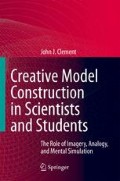This chapter discusses an approach to teaching basic physics concepts that utilizes some of the learning strategies that have been identified for experts in this book. Research has shown that physics students can harbor persistent preconceptions which can constitute difficult barriers to learning and are often quite resistant to instruction (for reviews of research on students' alternative conceptions, see Driver and Easley, 1978; Driver and Erickson, 1983; Duit, 1987; McDermott and Redish, 1999; Confrey (1990)). The teaching interviews to be discussed illustrate how strategies such as the use of analogies, bridging analogies, and explanatory models can help students deal with such preconceptions. We have seen in the last two chapters that under certain conditions students can use analogical reasoning and other plausible reasoning processes used by experts. The question is whether these natural reasoning resources can be tapped and organized in such a way as to produce conceptual change during instruction.
Such strategies would take advantage of positive elements of prior knowledge by building on students' existing valid physical intuitions. It is perhaps confusing that we are attempting to build on students conceptions in order to change their conceptions. However, there is evidence that students have both useful and competing intuitive conceptions (from the perspective of the scientific theory being taught). (See Clement et al. (1989) for documentation of such useful ‘anchoring’ intuitions.) In this teaching approach we attempt to increase the range of application of the useful intuitions and decrease the range of application of the competing intuitions. We hope to present evidence that such instruction can lead to conceptual change in that the student can make intuitive sense of aspects of the scientific theory that were counterintuitive before.
Access this chapter
Tax calculation will be finalised at checkout
Purchases are for personal use only
Preview
Unable to display preview. Download preview PDF.
Editor information
Editors and Affiliations
Rights and permissions
Copyright information
© 2008 Springer Science + Business Media B.V.
About this chapter
Cite this chapter
Clement, J.J., Brown, D.E. (2008). Using Analogies and Models in Instruction to Deal with Students' Preconceptions*. In: Clement, J.J. (eds) Creative Model Construction in Scientists and Students. Springer, Dordrecht. https://doi.org/10.1007/978-1-4020-6712-9_10
Download citation
DOI: https://doi.org/10.1007/978-1-4020-6712-9_10
Publisher Name: Springer, Dordrecht
Print ISBN: 978-90-481-3023-8
Online ISBN: 978-1-4020-6712-9
eBook Packages: Humanities, Social Sciences and LawEducation (R0)

